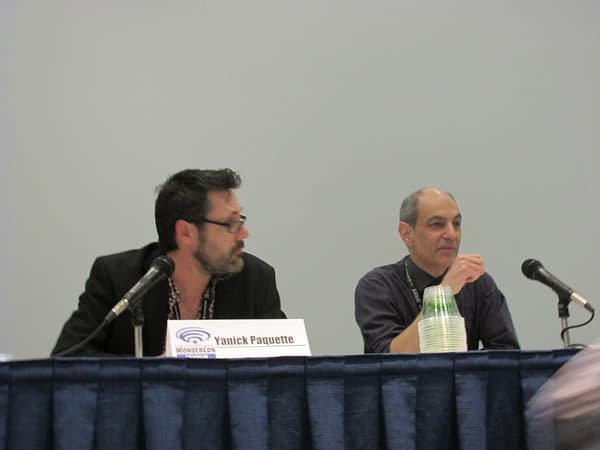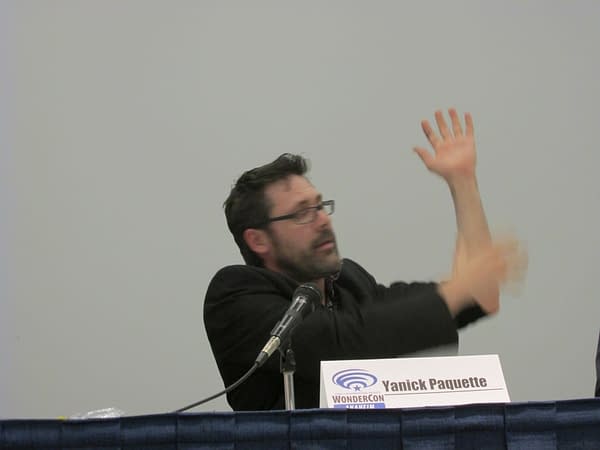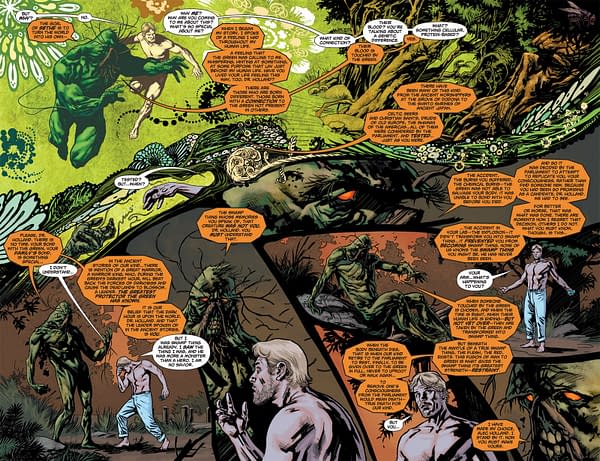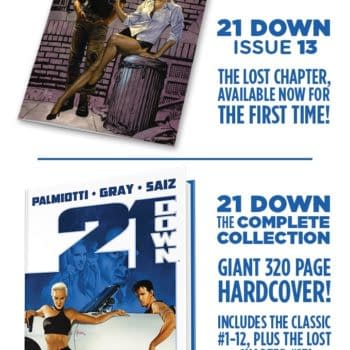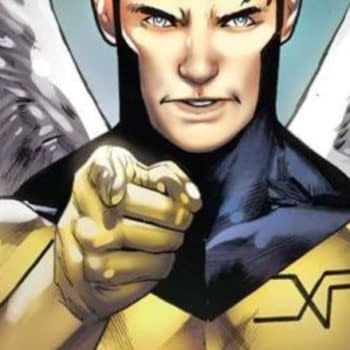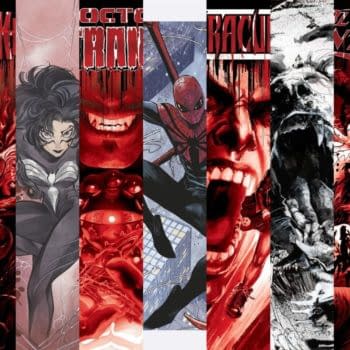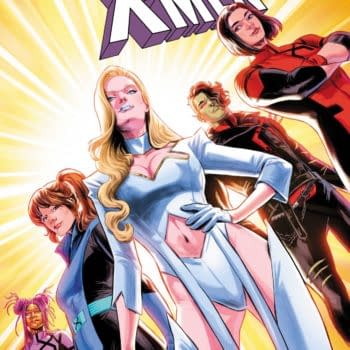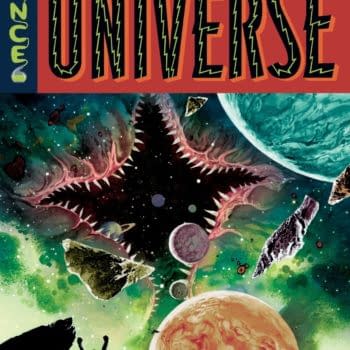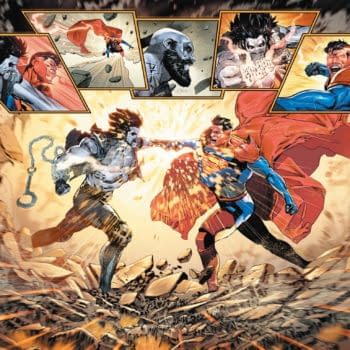Posted in: Comics | Tagged: Alan Moore, Comics, dc comics, entertainment, grant morrison, Marvel Comics, Seven Soldiers of Victory, swamp thing, Terra Obscura, Widlstorm, wonder woman, wondercon, yanick paquette
Yanick Paquette At Wondercon: The Lowly Entomologist Makes Good In Comics, Collects 'Crazy Writers'
After a heavy traffic day at Wondercon (and things are just heating up really for the big day, Saturday), fans found it amenable to chill out with Yanick Paquette who definitely brings the cool with his long history in comics and what many fans may not know was a strange journey for him.
Larry Ganem hosted the spotlight panel on Paquette and started off with his early career.
Paquette explained: "My first intention was to be a biologist and discover species". To discover insects and give them his own name was the "pretentious goal of my life", he said. He was about to become an entomologist when he had an "epiphany" that the job was not what he thought it would be. There would be no forests and jungles, and he wanted an "adventurous life fighting malaria". The actual jobs in entymology, he found, were surveying crops.
He decided in his early 20's to abandon the pursuit, but was "always drawing" throughout. His second choice was classical music, and he still dabbles in composition, like the orchestral score he wrote for Swamp Thing # 7 and 8. (You can find the link to it on his Facebook page).
But, in the end, he chose the "safest route" of all his options, being a comic book artist.
Paquette is from Montreal, which he deems a "crossroad of American and European culture" and he could have linked to either in his comics. He had grown up mostly reading translations in French of old EC comics. American comics seemed in opposition to European styles, which were "very cartoony" and American comics felt a lot more "realistic" to him, based on artists like Hal Foster. He chose the American market, because he was inclined to draw more realistically.
But by the time be broke into comics, he seemed to have an "older style of classical illustration" and wasn't necessarily the norm since superhero comics had branched into more stylized forms, but he found employment by working for Tops Comics doing an issue of X-Files in a realistic style.
In the end, the comic never got published because of a change in the franchise. But he doesn't feel his work was that great at the time. "As you start your career, every 200 pages you're twice as good as when you started", he said and this was his learning period.
Around 1996, his work found its way into the hands of DC, after some work for Antarctic Press, even though he had no professional training, just learning as he worked to be more professional in style.
In fact, in school he had initially switched from biology to art, but he kept getting pushed towards modern art, which was also not realistic in style. No one would teach him the basics like perspective since most of his teachers were abstract painters. The art at school was so modern that anatomy, architecture, and the physics of clothing, the things he really wanted to learn were out of the question. He was pushed toward commercial art by teachers. There was no Kubert School in Quebec, he laughed.
He knew that to do what he wanted to do, he would have to learn for himself, so he took biology and anatomy textbooks, and studied them. At this point in the panel, he started illustrating the way muscles work on his forearm by explanation, showing how each muscle moved and turned, and emphasized the importance of understanding anatomy in comics.
If you look at his early work, he said, "every muscle is showing up everywhere". But another epiphany arrived when he met Charles Vess who was visting Montreal and told him to "think about shape and form", and said, "Light is everything". Paquette spent some time reflecting on this, and started to draw light rather than muscles. He considered the idea that drawing is "shape described by light".
Still at this early stage in his work, he felt that he overdid his knowledge of anatomy, trying to "show off" his knowledge too much, and later began to think in terms of "composition" which is really what matters. Thinking of elements in a panel, for instance, like swamp thing, and the angles of characters and trees. These are all just "huge elements in space".
He didn't get a lot of feedback for his work from editors, because they didn't seem to have much problem with what he was doing, but he was offered fairly early on to work on a monthly book, Wonder Woman, in which he "suffered so much" due to lack of clear scheduling. The book would be written so far ahead that they felt they had plenty of time only to discover they were behind. This finally led to a "panic" where he had to produce a whole book in 2-3 weeks and the work was not good as a result. This "bad book", he said, was Wonder Woman # 136. DC let him know they were "changing direction", which was a gentle way of firing him. They offered for him to finish 2 more books on the series, and he pulled out all the stops and did some of his best work ever, thinking they would probably be his last work in comics. The two issues were so impressive that he wasn't fired, but offered more work.
Around this time, though, Mike Marts asked him to work on Gambit over on Marvel and though he did some strong work, the color separation company they were using at the time really destroyed his artwork. Finally, he couldn't take it any more and quit. He told Marts he was "firing myself on my own book", and it was a pretty extreme move for him. He called DC and let him know he was looking for work again, went to take a shower, and when he returned, there was a script waiting in his inbox. Crisis averted. "The shower was the turning point", he joked.
After doing some work at DC which included Code Name: Knockout for Vertigo, he got "drafted" at ABC/Wildstorm to work on Terra Obscura for 2 years.
Back then, he said, Alan Moore didn't have a computer and his fax machine was plugged into phone, so to talk to Alan, you had to send a fax first that you were going to call. ABC was a "heaven" to work with, though, he said, since the deadlines were flexible and the story content was "wild". You could do "anything", kill people, or change their sexual orientation because the characters were not icons, but "ideas of the icons" and this left Moore with the ability to do "all sorts of weird things".
He missed the boat on one project, though, when he was offered work on Ex Machina with Brian K. Vaughn, but turned it down because of the subject matter of cities and suits, which didn't appeal to him. But Grant Morrison ended up being "good for my collection of crazy writers", he said, "Collect them all!", when he signed on to do Bulleteer for Seven Soldiers of Victory.
He was used to getting massive scripts from Alan Moore, but Grant Morrison's scripts were only around 7 pages, with no dialogue, and he had no idea what to do. The scripts appeared in different colors and different sized fonts, so he called the editor, assuming the files had been corrupted somehow. "No, this is what you get", they told him.
He discovered that with Grant Morrison, "you find your way", as a work in progress. " He wants to be able to reinvent himself until the last minute, like a day before deadline", Paquette said, but he finds it "stimulating in a way" since "stuff is always fresh and raw".
Seven Soldiers was such ambitious craziness, into one final "make sense" final issue. Had a vague plan, but went in trying to find his way through the forest and be alive at the end.
Now Paquette is working with Grant Morrison again on a Wonder Woman graphic novel, which still has no dialogue in script form, "But I'm happy to report that I kind of know where I'm going now", he said. He's also happy with the "super prestige format" the Wonder Woman graphic novel will have. He's always wanted a "long shelf life", for his work, to create "a literary object with value for future generations", so he's very happy with it.
"We are exploring feminism and sexuality" in Wonder Woman, he said, a "a new take" on feminism and a "much more liberal sexuality" since Wonder Woman has a boyfriend. "Wonder Woman and Steve is such a modern equation", he said. In the 1940's it was "almost weird" to see Diana choosing a "mortal dude" even though guy superheroes were choosing mortals at the time. "Today it's happening", Paquette said, with "guys deciding to stay home and raise kids while women are making the living", and these "changes in the structure of power" were ahead of their time in Wonder Woman.
During the question and answer period, a fan commented that "What catches the eye about Yanick's work is the layout and panels, using foliage in Swamp Thing with energy and life in every page".
Paquette commented "I'm a huge fan of the Alan Moore era of Swamp Thing, with Bissette, Totelbein, and Veitch, so to me Swamp Thing and "experimental" goes together". He felt like he needed to bring "more experimental" elements into his work on Swamp Thing, so he "created a design for every panel depending on what the story was about".
When Alan Moore was "going into the green", Paquette said, there was "visually weird stuff" but with Scott Snyder Paquette went with very simple panels "but the layouts were crazy". They were "acidly weird", he said laughing at creating a new word. But this "all spun" from his intention of connecting with the past of the Swamp Thing comic. There are also plenty of Easter Eggs, he said, doing homage to previous Swamp Thing creators.
It's been a long, strange road for Yanick Paquette in comics, but it certainly sounds like his knowledge of biology really paid off, particularly when it came to working on Swamp Thing. Maybe we could do with a full orchestral treatment to accompany Wonder Woman? Just a thought.




